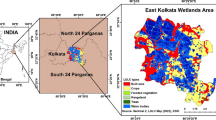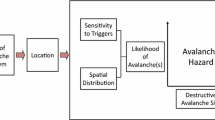Abstract
Ecological risk assessment is a common environmental management tool. It is routinely used for physical and chemical stressors, and has recently been used for biological stressors such as invasive species and genetically modified organisms. Identifying hazards correctly is critical to any risk assessment. In many ecological examples, however, this stage of the analysis is very poor. This paper applies a hazard-analysis tool that is commonly used in complex engineering systems – fault-tree analysis – to an ecological system – ballast-water introductions. The analysis, which is rigorous and systematic, highlights the complexity of the ballast-water introduction cycle. The top event in the fault-tree is the successful infection of a port. The fault-tree identifies the parallel and sequential events leading up to the top event, including multiple vessel-infection scenarios, determined by the origin (hard substrate, soft substrate, water column and another organism) and behaviour of the target organism. The analysis also identifies the role of ballast-tank populations, ballast-water carry-over, crevice-seeking species and third-party risks. These phenomena add considerably to the complexity of the problem. Fault-trees will have a limited application to ecological systems because of the difficulty of estimating the probability of the basic or undeveloped events in the tree. As this paper demonstrates, however, fault-tree analysis has considerable heuristic potential when applied to ecological systems.
Similar content being viewed by others
References
Andersen AB, Behrens HL, Bakke SM, Gravir G, Haugom GP and Moen TL (2000) BWTA – Integration Phase EMBLA, Report No 2000–3011, Det Norske Veritas, Hovedkontor, Norway, 113 pp
Anderson DM, Lively JJ, Reardon EM and Price CA (1985) Sinking characteristics of dinoflagellates cysts. Limnology and Oceanography 30(5): 1000–1009
Baltz DM (1991) Introduced fishes in marine systems and inland seas. Biological Conservation 56: 151–177
Barnthouse LW, Suter GW, Bartell SM, Beauchamp JJ, Gardner RH, Linder E, O'Neill RV and Rosen AE (1986) Users Manual for Ecological Risk Assessment. NTIS DE86–010063, ORNL-6251, National Technical Information Service, Springfield Virginia, 207 pp
Byrne M, Morrice MG and Wolf B (1997) Introduction of the northern Pacific asteroid Asterias amurensis to Tasmania – reproduction and current distribution. Marine Biology 127: 673–685
Carlton JT (1985) Transoceanic and interoceanic dispersal of coastal marine organisms: the biology of ballast-water. Oceanography and Marine Biology: an Annual Review 23: 313–371
Carlton JT (1996) Pattern, process and prediction in marine invasion ecology. Biological Conservation 78: 97–106
Carlton JT, Reid DM and van Leeuwen H (1995) The Role of Shipping in the Introduction Of Nonindigenous Aquatic Organisms to the Coastal Waters of the United States (other than the Great Lakes) and an Analysis of Control Options. Report No CG-D–11–95, NationalTechnical Information Service, Springfield, Virginia, 349 pp
Denny M, Brown V, Carrington E, Kraemer G and Miller A (1989) Fracture mechanics and the survival ofwave-swept macroalgae. Journal of Experimental Marine Biology and Ecology 127: 211–228
Dickman M and Zhang F (1999) Mid-ocean exchange of container vessel ballast-water. 2: effects of vessel type in the transport of diatoms and dinoflagellates from Manzanillo Mexico to Hong Kong, China. Marine Ecology Progress Series 176: 253–262
Ebbesmeyer CC, Francisco MD, Boatman CD, Norton D and Michelsen T (1995) Currents generated by vessel traffic along Seattle'swaterfront. In: Oceans 95 MTS/IEEE: Proceedings of the Conference, October 9–12, 1995, San Diego, California, Vol 1, pp 26–41. Institute of Electrical and Electronics Engineers, New York
Fairplay (1998) Fairplay Ports Guide. Fairplay Publications Ltd, Coulsdon, Surrey, UK
Fiksel JR and Covello VT (1985) The suitability and applicability of risk assessment methods for environmental application of biotechnology. In: Fiksel JR and Covello VT (eds) Biotechnology Risk Assessment: Issues and Methods for Environmental Introductions, pp 355–367. Pergamon Press, New York
Francis RICC (1992) Use of risk analysis to assess fishery management strategies: a case study using Orange Roughy (Hoplostethus atlanticus) on the Chatham rise, New Zealand. Canadian Journal of Fisheries and Aquatic Science 49: 922–930
Fuehrer M and Romisch K (1977) Effects of modern ship traffic on inland and ocean waterways and their structures. In: Proceedings of the PIANC 24th International Navigation Congress, Lenningrad, 1977, Paper S-I3, pp 1–15. General Secretariat of PIANC, Brussels, Belgium
Fuehrer M, Pohl H and Romisch K (1987) Propeller jet erosion and stability criteria for bottom protections of various constructions. Bulletin of the Permanent International Association of Navigation Congresses 58: 45–56
Gollasch S, Dammer M, Lenz J and Andres HG (1998) Nonindigenous organisms introduced via ships into German waters. In: Carlton JT (ed) ICES Cooperative Research Report 224 – Ballast-Water: Ecological and Fisheries Implications. International Council for the Exploration of the Sea, Copenhagen, Denmark
Groves RH, Panetta FD and Virtue JG (2001) Weed Risk Assessment. CSIRO Publishing, Collingwood, Australia, 244 pp
Haimes YY (1998) Risk Modeling, Assessment and Management. John Wiley & Sons, New York, 726 pp
Hamill GA and Johnston HT (1993) The decay of maximum velocity within the initial stages of a propeller wash. Journal of Hydraulic Research 31(5): 605–613
Hayes KR (1998) Bayesian Statistical Inference in Ecological Risk Assessment. CRIMP Technical Report 17, CSIRO Division of Marine Research, Hobart, Australia, 94 pp
Hayes KR (2003) Biosecurity and the role of risk-assessment. In: Ruiz GM and Carlton JT (eds) Bioinvasions: Pathways, Vectors, and Management Strategies. Island Press, Washington, DC (in press)
Hayes KR and Hewitt CL (1998) Risk Assessment Framework for Ballast-Water Introductions. CRIMP Technical Report 14, CSIRO Division of Marine Research, Hobart, Australia, 75 pp
Hayes KR and Hewitt CL (2000) Risk Assessment Framework for Ballast-Water Introductions – Volume II. CRIMP Technical Report 21, CSIRO Division of Marine Research, Hobart, Australia, 190 pp
Hewitt C and Martin RB (1996) Port Surveys for Introduced Marine Pests, CRIMP Technical Report 4, CSIRO Marine Laboratories, Hobart, Australia, 40 pp
Hewitt CL, Campbell ML, Thresher RE and Martin RB (1999) Marine Biological Invasions of Port Phillip Bay, Victoria. CRIMP Technical Report 20, CSIRO Division of Marine Research, Hobart, Australia, 344 pp
Hope S, Bjordal EN, Diack HM,Eddershaw BW, Joanny L, Ortone G, Payne FG, Searson AH, Sedlacek KW and Strien W (1982) Methodologies for Hazard Analysis and Risk Assessment in the Petroleum Refining and Storage Industry. CONCAWE Report 10/82, CONCAWE, The Hague, The Netherlands, 96 pp
Hunter JR (1997) Simple Modelling of the Withdrawal of Ballast-Water by Ships, CMR Report 94/111, CSIRO Division of Marine Research, Hobart, Australia, 16 pp
Johnstone IM (1986) Plant invasions windows: a time based classi-fication of invasion potential. Biological Review 61: 369–394
Jones MM (1991) Marine Organisms Transported in Ballast-Water: A Review of the Australian Scientific Position. Bureau of Rural Resources, Bulletin No 11, Australian Government Publishing Service, Canberra, Australia, 48 pp
Kellar JA (1993) The application of risk analysis to international trade in animal and animal products. Revue Scientifique et Technique de l'Office International des Epizooties 12(4): 1023–1044
Kelleher G, Bleakley C and Wells S (1995) A Global Representative System of Marine Protected Areas, Vols 1–4. The International Union for the Conservation of Nature, Washington, DC
Kiorboe T, Hansen JLS, Alldredge AL, Jackson GA, Passow U, Dam HG, Drapeau DT, Waite A and Garcia CM (1996) Sedimentation of phytoplankton during a diatom bloom: rates and mechanisms. Journal of Marine Research 54: 1123–1148
Kletz TA(1986) HAZOP & HAZAN: Notes on the Identification and Assessment of Hazards. The Institution of Chemical Engineers, Warwickshire, UK, 94 pp
MacIsaac HJ, Robbins TC and Lewis MA (2002) Modeling ships' ballast water as invasion threats to the Great Lakes. Canadian Journal of Fisheries and Aquatic Science 59: 1245–1256
Martin R and Sutton C (2000) Survival of Target Taxa in Ballast Tanks. Final Report for the Strategic Ballast-water Research and Development Program, Project No 8/98, CSIRO Division of Marine Research, Hobart, Australia, 28 pp
Morley RS (1993) A model for the assessment of the animal disease risks associated with the importation of animals and animal products. Revue Scientifique et Technique de l'Office International des Epizooties 12(4): 1055–1092
Moyle PB and Light T (1996) Biological invasions of fresh water: empirical rules and assembly theory. Biological Conservation 78: 149–161
Murphy KR (1997) The Survival and Sampling of Zooplankton in Ballast-water. Thesis, Department of Zoology, University of Tasmania, Hobart, Australia, 90 pp
National Research Council (1983) Risk Assessment in the Federal Government: Managing the Process. National Academy Press, Washington, DC
Pate-Cornell ME (1984) Fault-trees vs event trees in reliability analysis. Risk Analysis 4(3): 177–186
Pearson WD, Killgore JK, Payne BS and Miller AC (1989) Environmental Effects of Navigation Traffic: Studies on Fish Eggs and Larvae. US Army Engineers Technical Report EL–89–15, US Army Engineer Waterways Experiment Station, Vicksburg, Massachusetts, 35 pp
Prosser MJ (1986) Propeller Induced Scour. Report reference 2570, BHRA, The Fluid Engineering Centre, Cranfield, Bedford, UK, 39 pp
Punt AE and Hilborn R (1997) Fisheries Stock Assessment and Decision Analysis: The Bayesian Approach. CSIRO Division of Marine Research, Hobart, Australia, 36 pp
SarjeantWAS, Lacalli T and Gaines G (1987) The cysts and skeletal elements of dinoflagellates: Speculations on the ecological causes for their morphology and development. Micropaleontology 33(1): 1–36
Schobben HPM and Scholten MCTh (1993) Probabilistic methods for marine ecological risk assessment. ICES Journal of Marine Science 50: 349–358
Smayda TJ (1970) The suspension and sinking of phytoplankton in the sea. Oceanography and Marine Biology: an Annual Review 8: 353–414
Thomas WH and Gibson CH (1990) Effects of small scale turbulence on microalgae. Journal of Applied Phycology 2: 71–77
Verhey HJ (1983) The Stability of Bottom and Banks Subjected to the Velocities in the Propeller Jet Behind Ships. Delft Hydraulics Laboratory Publication No 303, Delft Hydraulics Laboratory, Delft, The Netherlands, 11 pp
Williams RJ, Griffiths FB, Van derWall EJ and Kelly J (1988) Cargo vessel ballast-water as a vector for the transport of non-indigenous marine species. Estuarine, Coastal and helf Science 26: 409–420
Wonham MJ, Carlton JT, Ruiz GM and Smith LD (2000) Fish and ships: Relating dispersal frequency to success in biological invasions. Marine Biology 136: 1111–1121
Author information
Authors and Affiliations
Rights and permissions
About this article
Cite this article
Hayes, K.R. Identifying Hazards in Complex Ecological Systems. Part 1: Fault-tree Analysis for Biological Invasions. Biological Invasions 4, 235–249 (2002). https://doi.org/10.1023/A:1020979914453
Issue Date:
DOI: https://doi.org/10.1023/A:1020979914453




